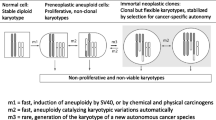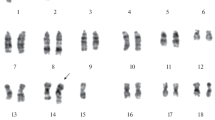Summary
Despite more than 50 attempts and the use of various methods, it has been impossible to establish homologous hybridomas between human mature macrophages and 8-azaguanine-resistant U-937 clones prepared in the laboratory. To rule out the possibility that these clones were unsuitable for the selection of hybrids, a study of their properties was done. It was shown that U-937 wild type cells were able to produce HPRT, whereas 8-azaguanine (8-aza)-resistant clones did not. Curiously, exonic and intronic HPRT sequences were undetectable both in wild type and in 8-aza-resistant cell genomes, under conditions where they were detected in control cells. Chromosome analysis of the clone UM9, one of the most frequently used in fusion experiments, revealed many qualitative and quantitative differences with the U-937 wild type cells. 8-aza-resistant U-937 cells were capable of fusion with human macrophages and gave rise to heterokaryons and probably to synkaryons, which survived for weeks without dividing in hypoxanthine-aminopterin-thymidine medium. The results could be interpreted in terms of the existence of a transacting negative regulatory mechanism of the macrophage genome on the proliferative capacity of homospecific hybridomas.
Similar content being viewed by others
References
Baltassat, P.; Mousson, B.; Rissoan, M. C., et al. Optimized micromeasurement of HPRTase activity on fibroblasts and hair follicles. In: De Bruyn, C. H. M. M.; Simmonds, H. A.; Müller, M. M., eds. Advances experimental medicine and biology. [Purine metabolism in man. IV, part A], vol. 165A. New York and London: Plenum Press; 1984:257–260.
Bohbot, A.; Faradji, A.; Schmitt, M., et al. Establishment and characterization of somatic hybrids between human differentiated macrophages and mouse myeloma NS1 cells. Int. J. Cell Cloning 8:63–79; 1990.
De Carli, L.; Lariza, L. Induced chromosome variation in cultured cell populations. In: Barigozzi, C., ed. Progress in clinical biological research. [Origin and natural history of cell lines], vol. 26. New York: Plenum Press; 1978:93–124.
Dienstman, S. R.; Defendi, V. Necessary and sufficient conditions for recruitment of macrophages into the cell cycle. Exp. Cell Res. 115:191–199; 1978.
Dulbecco, R.; Vogt, M. Plaque formation and isolation of pure lines with poliomyelitis virus. J. Exp. Med. 99:167–182; 1954.
Dumont, S.; Hartmann, D.; Poindron, P., et al. Control of antitumoral activity of human macrophages produced in large amounts in view of adoptive transfer. Eur. J. Cancer Clin. Oncol. 24:1691–1698; 1988.
Feinberg, A.; Vogelstein, B. A technique for radiolabelling DNA restriction endonuclease fragments to high specific activity. Anal. Biochem. 137:266–267; 1984.
Hirsch, J. G.; Fedorko, M. E. Ultrastructure of human leukocytes after simultaneous fixation with glutaraldehyde and osmium tetroxide and “postfixation” in uranylacetate. J. Cell Biol. 38:615–627; 1968.
Margolskee, R. F.; Kavathas, P.; Berg, P. Epstein-Barr virus shuttle vector for stable episomal replication of cDNA expression libraries in human cells. Mol. Cell. Biol. 8:2837–2847; 1988.
Milman, G.; Lee, E.; Ghangas, G. S., et al. Analysis of HeLa cell hypoxanthine phosphoribosyltransferase mutants and revertants by two-dimensional polyacrylamide gel electrophoresis: evidence for silent gene activation. Proc. Natl. Acad. Sci. USA 73:4589–4593; 1976.
Pera, F.; Rainer, B. Studies of multipolar mitoses in euploid tissue cultures. I. Somatic reduction to exactly haploid and triploid chromosomes sets. Chromosoma 42:71–86; 1973.
Rizzoni, M.; Palitti, F.; Perticone, P. Euploid segregation through multipolar mitosis in mammalian cell cultures. Identification of triploid, haploid, and segregating diploid cells in a diploid-euploid primary culture of rhesus kidney cells. Chromosoma 45:151–162; 1974.
Shimoda, O.; Takeda, Y.; Woo, H. J., et al. A human macrophage hybridoma producing a cytotoxic factor distinct from TNF, LT, and IL-1. Cancer Immunol. Immunother. 26:101–108; 1988.
Sperber, K.; Bauer, J.; Pizzimenti, A., et al. Identification of subpopulations of human macrophages through the generation of human macrophage hybridomas. J. Immunol. Methods 129:31–40; 1990.
Sundström, C.; Nilsson, K. Establishment and characterization of a human histiocytic lymphoma cell line (U-937). Int. J. Cancer 17:565–577; 1976.
Vernon, T.; Herzenberg, L. Immunoglobulin-producing hybrid cell lines. In: Mishell, B.; Shigii, M., eds. Selected methods in cellular immunology. Berkeley: University of California; 1980:351–372.
Woo, H. J.; Shimoda, O.; Imai, Y., et al. Homologous human macrophage hybridomas that produce a novel cytotoxic factor in their culture supernatants. Microbiol. Immunol. 32:97–114; 1988.
Yen, P. H.; Patel, P.; Chinault, A. C., et al. Differential methylation of phosphoribosyltransferase genes on active and inactive human X chromosomes. Proc. Natl. Acad. Sci. USA 81:1759–1763; 1984.
Author information
Authors and Affiliations
Rights and permissions
About this article
Cite this article
Bohbot, A., Uttwiller, F., Fujita, R. et al. Failure to obtain hybridomas between human macrophages and human tumoral U-937 cells is probably due to parental macrophages. In Vitro Cell Dev Biol - Animal 29, 362–370 (1993). https://doi.org/10.1007/BF02633983
Received:
Accepted:
Issue Date:
DOI: https://doi.org/10.1007/BF02633983




